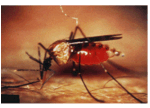DRY SEASON MALARIA TRANSMISSION
BACKGROUND& METHODS
 Because of its high average elevation and diverse topographies, Kenya supports a
wide variety of malaria situations, ranging from no transmission to
holoendemicity. The basin of Lake Victoria has one of the highest
transmission rates in the world. Around the provincial capital of Kisumu,
malaria is directly or indirectly responsible for nearly one third of the deaths
in children under 5 years old. The cost of nonfatal infections with Plasmodium
falciparum, P. malariae and P. ovale has not been estimated
but must be proportionately huge. As in most equatorial Africa, the
principal vectors are Anopheles gambiae, An. arabiensis, and An.
funestus. Western Kenya, which is heavily cultivated, has two distinct
wet seasons - April to August and November to January - when transmission is
intense, and intervening dry periods when Anopheles are rare and
incidence is low. Since P. falciparum gametocytemia is short lived, we are
interested in how transmission jumps from one rainy season to the next.
Because of its high average elevation and diverse topographies, Kenya supports a
wide variety of malaria situations, ranging from no transmission to
holoendemicity. The basin of Lake Victoria has one of the highest
transmission rates in the world. Around the provincial capital of Kisumu,
malaria is directly or indirectly responsible for nearly one third of the deaths
in children under 5 years old. The cost of nonfatal infections with Plasmodium
falciparum, P. malariae and P. ovale has not been estimated
but must be proportionately huge. As in most equatorial Africa, the
principal vectors are Anopheles gambiae, An. arabiensis, and An.
funestus. Western Kenya, which is heavily cultivated, has two distinct
wet seasons - April to August and November to January - when transmission is
intense, and intervening dry periods when Anopheles are rare and
incidence is low. Since P. falciparum gametocytemia is short lived, we are
interested in how transmission jumps from one rainy season to the next.
-
Determine the amount of dry season transmission occurring during the dry season
-
Identify the vector species responsible
-
Determine the population most at risk and devise a control strategy
Introduction:
Urban malaria is an increasing danger in Sub-Saharan Africa.
Usually considered a rural disease, malaria is constantly introduced into the
cities by migrants searching for employment. Because they are poor many migrants
live in makeshift, crowded quarters with little medical care or public
services. Where possible they cultivate plots nearby to supplement their
diet and travel back to visit their rural homes when they can.
Nairobi has been considered malaria free both because of its
urban environment and its altitude of 1600 m. But in 1999, a Centre for
Clinical Research scientist supported by USAMRU, Dr Robert Kimtai, found that
more than 40% of children microscopically diagnosed as having malaria at major
hospitals in Nairobi had no history of having left the city during the previous
3 months. Many of the infected children gave Kibera, a sprawling shantytown that
runs through southern Nairobi, as their home.
The objectives of this project are to determine
if transmission of malaria occurs in Nairobi and, if so, to incriminate
the vectors.
Study Design & Results
A section of Kibera where several cases of malaria had been found and that stood across a shallow river from where some crops were being cultivated was chosen. Three men made systematic morning resting collections of 20 houses, rotated daily, 3 times a week. During 2000, central Kenya experienced a severe drought and no Anopheles were found in collections during the first 11 months. But beginning in January 2001, as normal rain patterns resumed, small numbers of Anopheles gambiae and An arabiensis, as determined by PCR, began to be caught in the ratio of 1gambiae to 12 arabiensis. Species determination were made by PCR Thus far all have been negative for sporozoites by ELISA. Breeding sites have not yet been identified. Recently the project has been expanded to analyze the records of parasitologically confirmed malaria in children reporting to a clinic in Kibera newly opened by AMREF. We hope that by examining clusters of cases we will be able to concentrate on active foci.
